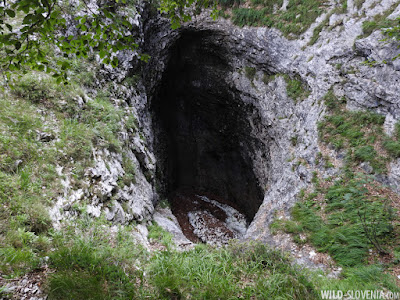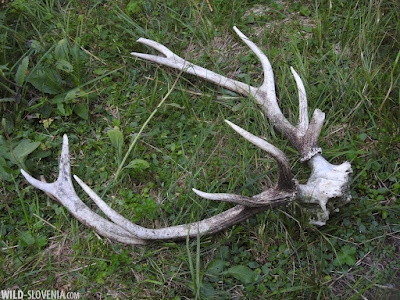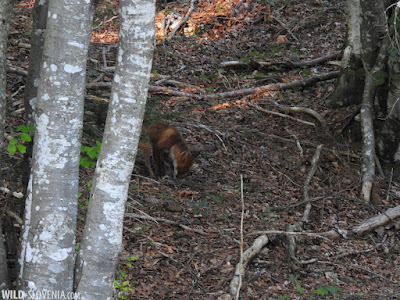
Although we live in the warmer, sub-Mediterranean part of Slovenia, the Karst still has a quite cool climate compared to the coast. Summer evenings and nights are therefore always fresh and enjoyable. However, last week's heat wave (+ 32 degrees C) was simply too much and we therefore decided to retreat to the Dinaric mountains for a couple of days. The Alps are also a strong draw at this time of year, but August is the peak tourist season and mountain paths (as well as huts) can be absurdly crowded. So the escape to the mountain forests of mount Snežnik seemed more appropriate. Indeed, during our two days in the wild, we barely encountered a human being - how lovely! We visited some nice patches of older, unmanaged forest, mostly exploring new areas, but also hoping to see some wildlife of course. Despite the altitude (1200-1500 metres a.s.l.), temperatures were rather high here too, but the wildlife didn't seem to notice that. The forest life was very active for this time of year and both birds and mammals gave us good entertainment.
First day we walked through a wild area of predominantly beech forest, with lots of dead wood and interesting fungi. Here we spotted a family of White-backed Woodpeckers Dendrocopos leucotos ssp. lilfordi (3 individuals) as soon as we entered an unmanaged part of the forest and then we observed a group of Red Deer Cervus elaphus stags with beautiful antlers, freshly "cleaned" from velvet. Some small patches of mountain meadows (old abandoned pastures) hosted interesting representatives of Snežnik's flora, including the typically Dinaric Campion-leaved Scabious Scabiosa silenifolia, as well as alpine species like Edelweiss Leontopodium alpinum. On the other side, most of the other plants in flower at the moment are the typical harbingers of autumn. Icing on the cake was a stunning male Honey Buzzard Pernis apivorus showing nicely at the side of a forest road.
 |
White-backed Woodpecker Dendrocopos leucotos ssp. lilfordi (male).
|
 |
Fresh White-back's feeding signs.
|
 |
Old White-back's feeding signs.
|
 |
Probable feeding signs of Black Woodpecker Dryocopus martius (note larger wood chips than above).
|
 |
On the lookout for forest wildlife.
|
 |
Mount Snežnik and its forests.
|
 |
Edelweiss Leontopodium alpinum
|
 |
Campion-leaved Scabious Scabiosa silenifolia - endemic to the Dinaric mountains & Apennines.
|
 |
Grass-of-Parnassus Parnassia palustris
|
 |
Liburnian Dwarf Gentian Gentianella liburnica
|
 |
Bellflower Campanula sp. (if on Snežnik, then it must be something not quite ordinary).
|
 |
Stemless Carline Thistle Carlina acaulis
|
 |
Willow Gentian Gentiana asclepiadea
|
 |
European Cotoneaster Cotoneaster integerrimus
|
 |
View eastwards from a mugo pine outcrop to mount Snežnik.
|
 |
A small part of the extensive forests on the Snežnik plateau.
|
 |
View NW with mount Nanos in the distance and the town of Pivka in the valley.
|
 |
Resting in a small clearing where last autumn we saw the bear featured here.
|
 |
The work of a hungry bear, digging for wood-boring larvae in a decaying beech trunk.
|
 |
One of the several puddles in the forest - the only source of water for wildlife on the Snežnik plateau.
|
 |
Brown Bear's footprint by the puddle.
|
 |
Unusually flat, clear and circular sites in the forest indicate old charcoal burning areas (if we are not mistaken, these were active on Snežnik until approx. the 1950s).
|
 |
Charcoal remains still abundant on the ground.
|
 |
Natural bridge in limestone.
|
 |
Surely the largest and oldest Sycamore Acer pseudoplatanus we know (completely hollow).
|
 |
Decaying wood with fungal surprise...
|
 |
Dryad's Saddle Polyporus squamosus - an uncommon bracket fungus we've seen only a couple of times.
|
 |
Artist's Bracket Ganoderma applanatum
|
 |
Lurid Bolete Boletus luridus
|
 |
Dutchman's Pipe (Yellow Bird's-nest) Monotropa hypopitys - an uncommon chlorophyll-lacking parasite.
|
 |
Sowbread Cyclamen purpurascens
|
 |
Wood Ragwort Senecio fuchsii (S. ovatus)
|
 |
Peacock Butterfly Aglais io on Sambucus ebulus
|
 |
Small Tortoiseshell Aglais urticae on Eupatorium cannabinum
|
 |
A lovely (and rather large) forest clearing, once used for grazing.
|
 |
Honey Buzzard Pernis apivorus (male).
|
 |
Beehives in the forest with electric fencing against hungry bears.
|
 |
An inquisitive Fox Vulpes vulpes
|
The next morning we visited an area of mixed forest with some old conifer stands, where we came across a hooting Ural Owl Strix uralensis and several other common forest birds. We searched for Three-toed Woodpecker Picoides tridactylus, but with no success. However, walking a steep rocky forest slope we "flushed" a Brown Bear Ursus arctos that
we actually only heard grunting and running away, around 50 metres away from us. The forest was also alive with the calls and flitting
movements of summer migrants on their way back to Africa: Pied Flycatchers Ficedula hypoleuca, Wood Warblers Phylloscopus sibilatrix and Spotted Flycatchers Muscicapa striata, while large clouds of House Martins Delichon urbicum and Swifts Apus apus were circling overhead. All in all an excellent couple of days in the forest!
 |
Ural Owl Strix uralensis
|
 |
Stand of Norway Spruce Picea abies on the edge of a karstic dolina.
|
 |
Greedy Red Squirrel Sciurus vulgaris carrying a fungus up a tree.
|
 |
Brown Bear's claw marks and the sign of a forest reserve (double blue line). Bears know where it's nice!
|
 |
Natural forest with decaying wood.
|
 |
One of the many karstic sinkholes, probably leading into a cave.
|
 |
Small horizontal sinkhole (cave?), perhaps a bear's den.
|
 |
Brown Bear's signs are everywhere. Here some raspberry-flavoured droppings.
|
 |
Beeches Fagus sylvatica in the subalpine belt, curved by the action of the strong wind and snow-cover.
|
 |
Above the treeline and up into the Mountain Pine Pinus mugo stands.
|
 |
Sara working her way into (or out of?) the impenetrable Pinus mugo.
|
 |
Nice view northeast to the Loška dolina valley.
|
 |
Northern slope of mount Snežnik.
|
 |
Red Squirrel Sciurus vulgaris collecting Pinus mugo cones at the tree line.
|
 |
Young Robin Erithacus rubecula in the thick Mountain Pine stand.
|
 |
Beech trees in the subalpine belt form some amazing shapes.
|
 |
Selfie on the "Mother Beech" (in Slovenia beech is the mother of trees).
|











































































































